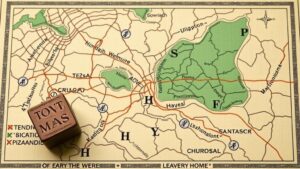Using Advanced Map Dowsing Techniques to Locate Mineral Deposits
Using Advanced Map Dowsing Techniques to Locate Mineral Deposits
Dowsing, a practice often associated with the quest for water, has found a niche within the field of mineral exploration. Advanced map dowsing techniques allow geologists and prospectors to identify potential locations of mineral deposits using maps and other representations of geographical data. This article explores the principles behind these techniques, supported by case studies and real-world applications.
Understanding Map Dowsing
Map dowsing involves the utilization of various tools, often including dowsing rods or pendulums, to assess geographic representations for signs of mineral deposits. This method relies on the belief that the dowsing instrument can detect subtle energy fields or vibrations related to the minerals below the surface.
Practitioners usually begin with a detailed map of the area in question, which may include topographic features, soil composition, and previous mineral survey data. The goal is to identify areas with a higher likelihood of containing mineral deposits without the need for extensive fieldwork.
Tools and Techniques
Several tools are commonly used in advanced map dowsing, including:
- Dowsing Rods: Traditionally made from flexible materials like metal or wood, these rods can detect changes in energy as the dowser moves over the map.
- Pendulums: A pendulum can swing in response to energy fields, providing clues about the presence and proximity of minerals.
Besides these tools, practitioners often apply techniques such as:
- Geographic Information Systems (GIS): GIS technology allows dowsers to analyze geographic data visually and spatially, increasing the accuracy of their assessments.
- Layering Data: Integrating multiple data layers–such as geological, hydrological, and historical mining data–can enhance the dowser’s understanding of the site.
Case Studies in Map Dowsing
Several successful applications of advanced map dowsing have been documented, showcasing its potential in the field of mineral exploration.
One notable example occurred in a remote region of South America, where an amateur dowser identified a vein of gold that had eluded professional surveyors. Using only a combination of topographic maps and intuition, the dowser pinpointed the location that later yielded a substantial gold deposit.
In another instance, a geological team in Australia integrated map dowsing with traditional exploration techniques and discovered a previously unexplored copper deposit. By employing advanced dowsing techniques in conjunction with geophysical surveys, they significantly reduced exploration costs while increasing success rates.
Benefits of Advanced Map Dowsing
The use of advanced map dowsing techniques offers several benefits to mineral locators:
- Cost-Effective: Dowsing can reduce the initial costs associated with exploration before committing to more expensive drilling operations.
- Environmental Impact: This method minimizes disruption to the landscape compared to traditional exploratory drilling.
- Speed: Map assessments can be performed swiftly, allowing for quick decision-making regarding further exploration.
Challenges and Considerations
Despite its potential, map dowsing does come with challenges that users must consider:
- Subjectivity: The effectiveness of dowsing can greatly depend on the dowser’s experience and sensitivity to energy changes.
- Scientific Skepticism: Many in the scientific community remain skeptical about the efficacy of dowsing, viewing it primarily as a pseudoscience.
- Integration with Traditional Methods: For best results, dowsing should be used in conjunction with geological surveys and other empirical methods.
Conclusion and Actionable Takeaways
Advanced map dowsing techniques offer a unique approach to locating mineral deposits, blending intuition with geographical analysis. While it presents clear benefits in terms of cost, time, and environmental impact, the subjectivity of the practice and skepticism from the scientific community are notable considerations.
For those interested in utilizing map dowsing:
- Invest in quality dowsing tools and familiarize yourself with their operation.
- Combine dowsing techniques with empirical geological data to enhance accuracy.
- Stay informed about the latest advancements in GIS technology to bolster your map analysis.
As techniques and tools evolve, map dowsing could become an increasingly valuable component of sustainable mineral exploration practices.



